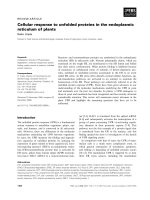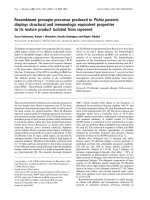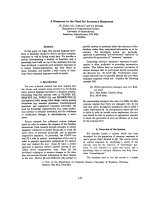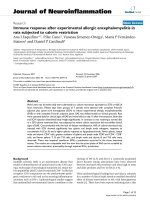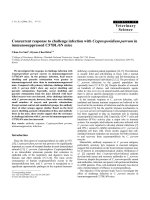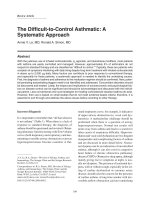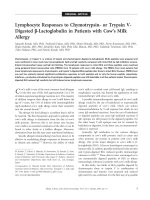Báo cáo y học: " Immune response to allergens in sheep sensitized to house dust mite" potx
Bạn đang xem bản rút gọn của tài liệu. Xem và tải ngay bản đầy đủ của tài liệu tại đây (519.15 KB, 11 trang )
BioMed Central
Page 1 of 11
(page number not for citation purposes)
Journal of Inflammation
Open Access
Research
Immune response to allergens in sheep sensitized to house dust
mite
Robert J Bischof*
1
, Ken J Snibson
2
, Joanne Van Der Velden
2
and
Els NT Meeusen
1
Address:
1
Animal Biotechnology Research Laboratories, Department of Physiology, School of Biomedical Sciences, Monash University, Clayton,
3800, Australia and
2
Centre for Animal Biotechnology, School of Veterinary Science, The University of Melbourne, Victoria, 3010, Australia
Email: Robert J Bischof* - ; Ken J Snibson - ; Joanne Van
Der Velden - ; Els NT Meeusen -
* Corresponding author
Abstract
Background: House dust mite (HDM) allergens are a major cause of allergic asthma. Most studies
using animal models of allergic asthma have used rodents sensitized with the 'un-natural' allergen
ovalbumin. It has only recently been recognized that the use of animal models based on HDM
provide a more relevant insight into the allergen-induced mechanisms that underpin human allergic
disease. We have previously described a sheep model of human allergic asthma that uses
Dermatophagoides pteronyssinus HDM. The present study extends our understanding of the immune
effects of HDM and the allergens Der p 1 and Der p 2 in the sheep model of asthma.
Methods: Peripheral blood sera from non-sensitized (control) sheep and sheep sensitized to HDM
was collected to determine immunoglobulin (Ig) reactivities to HDM, Der p 1 and Der p 2 by ELISA.
Bronchoalveolar lavage (BAL) fluid collected following allergen challenge was also assessed for the
presence of HDM-specific antibodies. To examine the cellular immune response to HDM allergens,
T cell proliferation and cutaneous responses were assessed in sensitized and control sheep.
Results: Strong HDM- and Der p 1-specific IgE, IgG
1
, IgG
2
and IgA serum responses were observed
in sensitized sheep, while detectable levels of HDM-specific IgG
1
and IgA were seen in BAL fluid of
allergen-challenged lungs. In contrast, minimal antibody reactivity was observed to Der p 2. Marked
T cell proliferation and late phase cutaneous responses, accompanied by the recruitment of
eosinophils, indicates the induction of a cellular and delayed-type hypersensitivity (DTH) type II
response by HDM and Der p 1 allergen, but not Der p 2.
Conclusion: This work characterizes the humoral and cellular immune effects of HDM extract
and its major constituent allergens in sheep sensitized to HDM. The effects of allergen in HDM-
sensitized sheep were detectable both locally and systemically, and probably mediated via
enzymatic and immune actions of the major HDM allergen Der p 1. This study extends our
understanding of the actions of this important allergen relevant to human allergic asthma and its
effects in sheep experimentally sensitized to HDM allergens.
Published: 20 October 2008
Journal of Inflammation 2008, 5:16 doi:10.1186/1476-9255-5-16
Received: 26 March 2008
Accepted: 20 October 2008
This article is available from: />© 2008 Bischof et al; licensee BioMed Central Ltd.
This is an Open Access article distributed under the terms of the Creative Commons Attribution License ( />),
which permits unrestricted use, distribution, and reproduction in any medium, provided the original work is properly cited.
Journal of Inflammation 2008, 5:16 />Page 2 of 11
(page number not for citation purposes)
Background
Many proteins of the house dust mite (HDM) Dermat-
ophagoides pteronyssinus are potent enzymes and represent
the most important allergens associated with human
allergic asthma [1]. The most extensively studied HDM
allergens are Der p 1 and Der p 2 and it has been shown
that the majority of HDM-sensitized asthmatic patients
(80–100%) have strong serum IgE responses to these
allergens [2].
The immunological and direct biological effects of HDM
allergens have been well documented in recent years.
Local and systemic immune effects of HDM allergens
include recruitment and activation of immune cells,
release of inflammatory mediators and the up-regulation
of pro-inflammatory adhesion molecules [3-5]. Der p 1,
the most immunodominant and widely studied HDM
allergen, is a cysteine protease with reported immune and
enzymatic effects in allergic human asthma [1]. Der p 1
proteolytic activity is thought to be a major contributor to
its allergenicity. Some of the reported actions of Der p 1
include direct immunomodulatory effects through cleav-
age/down-regulation of CD23 on B cells [6], CD25 on T
cells [7] and CD40 on dendritic cells [8], as well as the dis-
ruption of tight junctions in the bronchial epithelium
leading to increased cell permeability [9].
Most studies using animal models of allergic asthma have
used rodents and are based on sensitization and challenge
with the 'un-natural' allergen ovalbumin. With mounting
evidence for the potent role of HDM allergens in shaping
immune responses in the tissue microenvironment, there
is a need for more animal models that utilize the HDM
allergens as a more relevant model for the human disease
[1,10]. The development of in vivo animal models of
experimental asthma based on HDM allergens has raised
further interest in exploring the specific roles that natural
allergens play in allergic disease. HDM effects have been
investigated in small animal models of asthma [11-16],
while previous studies in our laboratory have reported the
effects of HDM in a sheep model of allergic asthma [17-
20].
The HDM sheep asthma model displays many of the char-
acteristic features of human allergic asthma including
HDM-specific IgE responses, eosinophilia, mucus hyper-
secretion of the airways, and airway remodeling following
chronic allergen exposure. A proportion of HDM allergic
sheep also develop increased airway resistance and airway
hyperreactivity similar to human asthmatics [20], validat-
ing the suitability of this experimental sheep asthma
model. The present study was undertaken to extend our
knowledge of the cellular and immune responses induced
by HDM and its major allergens, Der p 1 and Der p 2, in
sheep sensitized to HDM.
Methods
House dust mite (HDM) allergens
Whole extract of the Dermatophagoides pteronyssinus house
dust mite (HDM), was obtained from CSL Limited (VIC,
Australia), prepared in pyrogen-free saline (PFS; Baxter
Healthcare Pty. Ltd, NSW, Australia) and stored at -70°C
prior to use [17]. The concentration of HDM extract used
in the studies detailed below was based on the amount of
the crude HDM extract prepared in PFS. Immuno-affinity
purified Der p 1 obtained from cultured mites was kindly
provided by Dr Alan Brown (University of Nottingham,
UK). Recombinant Der p 2 was a generous gift from Dr
Wayne Thomas (University of Western Australia, Aus-
tralia).
Experimental sheep and sensitization with HDM
All experimental animal procedures and the collection of
tissues and cells were approved by the Animal Experimen-
tation Ethics Committee of the University of Melbourne,
following guidelines set by the National Health and Med-
ical Research Council (NH&MRC) of Australia. Female
Merino-cross lambs (4–5 months of age) used in these
studies were treated with the anthelminthic Nilverm™
(Cooper's Animal Health, NSW, Australia) to eliminate
any possible parasite infections prior to the experiment
and were housed in pens and fed ad libitum. All sheep were
judged free of significant pulmonary disease on the basis
of clinical examination.
Sheep (n = 8) were sensitized to HDM following 3 immu-
nizations with solubilized HDM (50 μg in aluminium
hydroxide) as outlined previously [17]; control (naïve)
animals (n = 6) were not immunized with HDM. Periph-
eral blood samples were collected from controls and at
pre- and post-immunization and stored frozen prior to
determination of immunoglobulin (Ig) reactivity. Immu-
nized animals that showed increased HDM-specific serum
IgE levels as assessed by ELISA (6 of the 8 immunized
sheep) were classified as allergic [17] and used as sensi-
tized sheep in the experiments.
Airway allergen challenges and collection of
bronchoalveolar lavage (BAL) samples
Four HDM-sensitized sheep were rested for 3 weeks fol-
lowing the final immunization, then given 2 airway chal-
lenges with HDM allergen (whole extract) at 3 week
intervals, using a fibre-optic bronchoscope as outlined
previously [17]. Bronchoalveolar lavage (BAL) samples
were collected 1 week before (0 h baseline timepoint) and
48 h after instillation of HDM allergen into the airways
using a fibre-optic bronchoscope [17], cells separated by
centrifugation, and BAL supernatants frozen for later
determination of antibody reactivity.
Journal of Inflammation 2008, 5:16 />Page 3 of 11
(page number not for citation purposes)
Detection of antibody responses to HDM allergens
Conventional enzyme-linked immunosorbent assay
(ELISA) was used for the detection of IgE, IgG
1
and IgG
2
,
IgA and total Ig against HDM allergens in peripheral
blood serum and BAL samples, as detailed previously
[17]. Briefly, ELISA plates coated with HDM (0.5–10 μg/
well), Der p 1 (0.75 μg) or Der p 2 (0.75 μg), were blocked
and washed prior to incubation with triplicate serum sam-
ples (diluted 1/1000). For the IgE ELISA, serum samples
were NH
4
SO
4
-treated prior to analysis as described [17].
Following washes, plates were incubated with anti-ovine
IgG
1
or IgG
2
(clone 7732, 4243 [21]), anti-ovine IgE
(YD3/XB6 [22]) or anti-bovine IgA (VMRD Inc., WA,
USA) mAb, then washed and incubated with horseradish
peroxidase (HRP)-conjugated rabbit anti-mouse Ig
(Dako, CA, USA). For total Ig determination, HDM-
coated plates were incubated with HRP-conjugated swine
anti-sheep Ig (Dako). Plates were then washed, developed
with 3', 3', 5', 5'-tetramethyl-benzidine dihydrochloride
hydrate (TMB; Sigma, NSW, Australia) and optical density
(OD) determined with a TitreTek Multiscan MCC plate
reader using a dual wavelength (A
450
-A
690
).
Proliferation assays
Peripheral blood was drawn from the jugular vein of sen-
sitized and control animals and placed into a collecting
tube containing ethylamine tetra-acetic acid (EDTA). Red
blood cells were lysed with the addition of Tris-buffered
ammonium chloride (TAC; 0.17 μM Tris, 0.16 μM NH
4
Cl,
pH 7.2) at 39°C. White blood cells were layered over
Ficoll (Sigma), peripheral blood mononuclear cells
(PBMCs) collected from the interface and washed twice
with sterile phosphate-buffered saline (PBS), then resus-
pended in DMEM tissue culture media (Invitrogen, Life
Technologies, VIC, Australia) supplemented with 10%
foetal bovine serum (FBS), penicillin, streptomycin, L-
glutamine and 2-mercaptoethanol (4 μM).
PBMCs collected from sensitized and control animals
were plated out into 96-well flat-bottom plates at 5 × 10
5
cells/well in a volume of 200 μl. Antigens were added in
triplicate at 10 μg/ml and cells were incubated at 37°C/
5% CO
2
for 4 days. Control cultures containing no anti-
gen or concanavalin A (conA, 1 μg/ml; Sigma) were also
included. DNA synthesis was measured with the addition
of
3
H thymidine (0.5 μCi; DuPont, Wilmington, DE,
USA) during the final 16–18 h of culture. Cultures were
harvested onto glassfibre filter mats and thymidine incor-
poration measured using a Packard beta counter. Results
are presented as counts per minute (c.p.m.).
Intradermal skin testing and dermal biopsy samples
Immediate and delayed cutaneous responses were
assessed in sensitized and control sheep following intra-
dermal (i.d.) injection with 100 μl of either HDM (100
μg/ml of crude extract), Der p 1 (5 μg/ml) or Der p 2 (5
μg/ml) in PBS. Control sites included challenge with PBS,
ovalbumin (10 μg/ml; Sigma) in PBS as irrelevant antigen
and histamine diphosphate (10 μg/ml; Sigma) as a posi-
tive control. Sheep were restrained while duplicate intra-
dermal injections were made on the clipped flank using a
29 g needle/BD Ultra-Fine™ insulin syringe (BD, NJ, USA).
Wheal reactions were scored at 0.25, 0.5, 1, 3, 5, 24, and
48 h post-challenge, calculated as the mean of two meas-
urements of the wheal diameters made at right angles to
each other using calipers.
Dermal (skin) biopsy samples were collected from an un-
injected site as a control, and from one of each of the
injection sites at 6 h and again at 48 h, fixed in 4% para-
formaldehyde (PFA) in PBS and processed to paraffin for
histology and immunochemistry.
Histology and immunochemistry of dermal tissues
Paraffin-processed dermal tissue samples collected from
sensitized and control animals were serial-sectioned (5
μm) for histological staining and immunochemistry.
Eosinophil counts were determined in paraffin sections
stained with Giemsa stain (Sigma). Mast cells were
detected in paraffin sections by immunochemical staining
[23] using a polyclonal rat anti-ovine tryptase antibody,
kindly provided by Prof Hugh Miller (University of Edin-
burgh, UK); all sheep dermal and lung mast cells are tryp-
tase-positive [24]. Briefly, PFA-fixed tissue sections were
incubated with 10% FBS in PBS to block non-specific
binding sites, followed by incubation with anti-ovine
tryptase Ab (1:250 in PBS), then washed and incubated
with HRP-conjugated rabbit anti-rat Ig (Dako). Sections
were developed with 3,3'-diaminobenzidine tetrahydro-
chloride (DAB; Sigma) and counterstained with H&E.
Eosinophils and mast cells were counted in a minimum of
20 successive graticule squares, an area of 1.25 mm
2
, using
a light microscope at 400× magnification. Cells were
counted in the upper dermis and lower dermis (area lying
between the skin glands and deeper muscle layer), and
intravascular cells were excluded from the count.
Statistical analyses
Parametric statistical analyses of the data was carried out
using Student's t-test to determine any significant differ-
ences (p < 0.05) between means of sample groups.
Results
Antibody responses to HDM and the dust mite allergens
Der p 1 and Der p 2
ELISAs were performed to determine IgE, IgG
1
, IgG
2
, IgA
and total Ig reactivities with HDM extract and the aller-
gens Der p 1 and Der p 2 in serum samples from HDM-
Journal of Inflammation 2008, 5:16 />Page 4 of 11
(page number not for citation purposes)
immunized and control (non-immunized) sheep. Sheep
were classified as sensitized (allergic) on the basis of
increased HDM-specific serum IgE levels. HDM-immu-
nized animals displayed a greater than 2-fold increase in
mean serum HDM-specific IgE levels compared to control
sheep (Fig. 1). A significant increase in mean levels of
HDM-specific IgG
1
, IgG
2
, IgA and total Ig was also
detected in immunized compared to control sheep. Serum
antibody reactivity to the HDM allergens Der p 1 and Der
p 2 appeared more variable than that seen with the HDM
preparation. Mean antibody levels were elevated (p <
0.05) for Der p 1-specific IgG
1
, IgG
2
, IgA and total Ig in
immunized compared to controls, while no Der p 2 spe-
cific antibodies were detected in any of the serum samples
assayed (Fig. 1).
BAL samples were collected before and after airway aller-
gen challenges in HDM-sensitized sheep, and assayed by
ELISA for HDM-specific IgE, IgG
1
, IgG
2
, IgA and total Ig
(Fig. 2). The levels of IgG
1
, IgA and total Ig were all ele-
vated (p < 0.05) at 48 h following the first, and similarly
the second, airway challenge compared to baseline (0 h).
In contrast, HDM-specific IgE and IgG
2
in BAL fluid
showed little change above baseline in the 4 animals
tested.
T cell proliferative responses to HDM and Der p 1 are
elevated in sensitized sheep
PBMCs from HDM-sensitized and control sheep were
stimulated with HDM or the HDM allergens Der p 1 and
Der p 2 (Fig. 3). Strong T cell proliferative responses to
HDM extract were observed in PBMCs from all sensitized
sheep, in contrast to the control animals where the cell
responses were minimal or negligible. A similar response
pattern was seen following stimulation with Der p 1,
although in the sensitized animals these responses were
weaker compared to HDM. The Der p 2 allergen had no
significant effect on T cell proliferation.
Cutaneous hypersensitivity responses to HDM allergens
Skin reactions following cutaneous challenge with HDM,
Der p 1 and Der p 2 were assessed in control and HDM-
sensitized sheep. Immediate skin wheal reactions were
observed within 15 minutes following injections with
HDM extract and Der p 1 in all sheep (Fig. 4A and 4B). An
immediate response to Der p 2 was elicited in 3 of the 5
sensitized sheep examined but absent in all controls (Fig.
4C). These acute responses, of similar magnitude to that
elicited by histamine (Fig. 4D), persisted through the first
hour post-challenge before declining over the 3–5 h
period. Delayed-type hypersensitivity (DTH) responses
were observed at 24–48 h for HDM extract and Der p 1 in
sensitized but not in the control sheep (Fig. 4A and 4B).
There was no indication of a DTH response following
intradermal challenge with Der p 2 (Fig. 4C).
Cellular changes in skin following challenge with HDM
allergens
Histological examination of tissue sections prepared from
skin biopsies at 48 h following intradermal challenge with
HDM allergens showed a prominent influx of eosinophils
into the upper and lower dermis in skin of HDM-sensi-
tized compared to control sheep (Fig. 5). Dermal tissue
sections stained for mast cell tryptase showed positive
staining of mast cells throughout the dermis, with mast
cells distributed sporadically in the stroma and in close
proximity to blood vessels (Fig. 5C–D).
The enumeration of eosinophils and mast cells in sensi-
tized and control tissues confirmed that there was a signif-
icant recruitment of eosinophils into the deeper dermal
layers following allergen but not saline challenge (Fig. 6).
This could already be detected at the 6 h time-point in the
lower dermis of both sensitized and control sheep, but
showed a further increase at 48 h post-allergen challenge
in sensitized sheep only. This was coincident with the
DTH responses described earlier. At 48 h post-challenge,
tissue eosinophil numbers, in both sensitized and control
tissues, were greater (p < 0.05) in both upper and lower
regions of the dermis following HDM and Der p 1 com-
pared to saline injection alone. In contrast to eosinophils,
mast cell numbers did not vary with treatment or time-
point in sensitized and control tissues.
Discussion and conclusion
We have previously described a sheep model for human
allergic asthma based on sensitization and challenge with
Dermatophagoides pteronyssinus house dust mite (HDM)
allergens [17,19,20]. In the present study we investigated
the local and systemic immune effects of HDM and the
major HDM allergens Der p 1 and Der p 2 in sheep.
The HDM allergens have been characterized and studied
in detail in vitro, and we are only beginning to appreciate
the need to focus on the direct and indirect mechanisms
through which these relevant allergens direct the patho-
physiology of allergic disease through in vivo models. The
present study shows that sheep sensitized to HDM aller-
gens display cellular and immune responses to HDM as
well as to Der p 1, the major HDM allergen. The local and
systemic effects of Der p 1 were generally found to parallel
HDM with respect to the induction of HDM-specific anti-
bodies, T cell proliferation and cellular recruitment fol-
lowing cutaneous challenge. This would suggest that in
the sheep asthma model the effects of HDM may largely
be mediated through Der p 1. In comparison to Der p 1,
there was little response seen with Der p 2. This may have
been due to non- or low reactivity to this allergen in
sheep, or it may be that the recombinant Der p 2 used in
the present study is not expressed in the appropriate con-
formation. In addition, previous studies have shown con-
Journal of Inflammation 2008, 5:16 />Page 5 of 11
(page number not for citation purposes)
Systemic IgE, IgG
1
, IgG
2
, IgA and total Ig antibody reactivities to HDM extract, Der p 1 and Der p 2 in serum from control and HDM-immunized sheepFigure 1
Systemic IgE, IgG
1
, IgG
2
, IgA and total Ig antibody reactivities to HDM extract, Der p 1 and Der p 2 in serum
from control and HDM-immunized sheep. Peripheral blood serum samples were collected before (open bars) and 7 days
after (closed bars) the final HDM injection, with time-matched serum samples also collected from control animals. In each of
the plots, ELISA data is presented as mean absorbance values ± s.d. * indicates significant differences (p < 0.05) comparing sam-
ples collected before and after HDM exposure; n = 3–4 per group.
0
0.5
1
1.5
2
*
0.5
0.4
0.3
0.2
0.1
0
*
IgE
IgG
1
IgG
2
IgA
Total Ig
*
0
0.2
0.4
0.6
0.8
*
*
absorbance
0
0.1
0.2
0.3
0.4
0.5
*
*
0
0.5
1
1.5
2
2.5
control sensitized control sensitised control sensitized
*
*
HDM Der p 1 Der p 2
Journal of Inflammation 2008, 5:16 />Page 6 of 11
(page number not for citation purposes)
siderable polymorphism of Der p 2 allergens resulting in
variable antibody and T cell responses [25].
The investigation of HDM-specific BAL Ig levels revealed a
significant local Ig response, with a predominance of IgG
1
and IgA, in allergen-challenged lungs. IgG
2
and IgG
1
anti-
body isotypes in ruminants are generally associated with
a type-1 or type-2 immune response respectively
(reviewed in [26]). The appearance of IgA antibodies is
not surprising given that the role of IgA at mucosal sur-
faces and in respiratory disease has been well acknowl-
edged [27,28]. The low levels of allergen-specific IgE in
BAL fluid compared to serum samples is not unlike that
seen in human subjects, where it has been reported that
BAL specific IgE may not be detected in all allergic individ-
uals, with lower levels seen in BAL fluid compared to
serum [29]. The sheep asthma model may serve as a useful
tool to further investigate the kinetics of local allergen-
specific antibody release into the BAL fluid following
allergen challenge and clarify the role of the different Ig
subclasses through the early and late-phases of the asth-
matic response.
Lymphocytes from sensitized sheep showed strong prolif-
erative responses to HDM extract and to some extent Der
p 1, suggesting the generation of Der p 1-specific memory
T cells after HDM sensitization and their involvement in
allergic responses in sheep. The comparatively weaker
responses to Der p1 may be due in part to the amounts of
allergen used (crude HDM extract versus purified Der p 1)
in these proliferation studies. The effects of HDM aller-
gens on T cell proliferation, activation and cytokine
release, has been reported in animal models and human
studies [30-33] and supports a Th
2
-driven mechanism in
allergic asthma.
Skin reactions observed following injection of HDM
extract and the allergens Der p 1 and Der p 2 in sensitized
sheep suggest an immediate hypersensitivity response,
generally attributed to degranulation of mast cells follow-
ing the crosslinking of IgE with allergen. However, an
immediate reaction following cutaneous HDM and Der p
1 challenge was also observed in control sheep, suggesting
a non-specific stimulation by HDM allergens. This could
be due to low levels of endotoxin known to be present in
natural and commercial house dust mite preparations and
shown to be a requirement for the development of allergic
lung inflammation [34]. It is likely that, mast cell release
of cytokines, inflammatory mediators and/or chemotactic
factors triggered the rapid appearance of eosinophils to
the site of inflammation within the first 6 h, as part of an
acute, non-specific response to allergen challenge [35-37].
Antibody release into BAL fluid following airway allergen challenge of HDM-sensitized, allergic sheepFigure 2
Antibody release into BAL fluid following airway allergen challenge of HDM-sensitized, allergic sheep. Antibody
reactivity to HDM was assessed in BAL fluid collected prior to the first airway challenge (0 h) and 48 h following two separate
airway challenges with HDM allergen (n = 4 allergic animals). ELISA data is presented as mean absorbance values ± s.d. * indi-
cates a significant difference (p < 0.05) compared to 0 h BAL samples.
48h post 2nd challenge
48h post 1st challenge
0h
*
*
*
*
*
*
IgE IgG
1
IgG
2
IgA Total Ig
3.0
2.5
2.0
1.5
1.0
0.5
0
absorbance
Journal of Inflammation 2008, 5:16 />Page 7 of 11
(page number not for citation purposes)
It is noteworthy that Der p 1 is capable of provoking
cytokine release by mast cells in the absence of IgE [38].
No change was seen in the number of mast cells between
HDM challenged and saline challenged skin of either con-
trol or sensitized sheep. Previous studies also did not
observe a change in mast cell numbers after allergen prov-
ocation of allergic patients, and attributed this to the rapid
replenishment of degranulated mast cells by migration of
mast cells from the blood vessels [39]. In the sheep
asthma model we have shown that mast cells are only sig-
nificantly increased in the airways after chronic allergen
exposure [19] and most likely play a significant role in the
airway inflammation and remodeling changes. In the
present study, the effects of a single cutaneous allergen
administration were more discernible in sensitized sheep
at 48 h post-challenge, with the appearance of a DTH reac-
tion to HDM and Der p 1. The skin DTH observations
were supported histologically with the recruitment of
eosinophils into the dermis, a characteristic feature of a
DTH type II response [40], and indicative of the more spe-
cific effects of allergen mediated via Th
2
driven immune
mechanisms at this later time point.
In this study we investigated the cell-mediated and
humoral immune effects of HDM extract and its constitu-
ent allergens Der p 1 and Der p 2 in sensitized (allergic)
compared to control, non-sensitized sheep. Both HDM
and Der p 1 were shown to have systemic and local
immune effects in sensitized sheep, and it is plausible to
suggest that the majority of effects of HDM are mediated
through its major allergen Der p 1. This study extends our
understanding of the allergic status of sheep experimen-
tally sensitized to house dust mite allergens, and the
HDM allergens induce the proliferation of blood lymphocytes from allergic sheepFigure 3
HDM allergens induce the proliferation of blood lymphocytes from allergic sheep. Proliferative response of PBMCs
from control (open circles; n = 6) and HDM-sensitized (closed circles; n = 6) sheep following stimulation in vitro with HDM
extract and the allergens Der p 1 and Der p 2. Data plotted as change in counts per minute from baseline (Δ c.p.m.). Dotted
horizontal lines depict the mean value for each group; * indicates significance (p < 0.05) for the corresponding allergens in sen-
sitized compared to control sheep.
0
10000
20000
30000
40000
50000
60000
70000
' c.p.m.
HDM Der p1 Der p2
*
control
HDM-sensitized
Journal of Inflammation 2008, 5:16 />Page 8 of 11
(page number not for citation purposes)
Skin wheal reactions in response to HDM allergensFigure 4
Skin wheal reactions in response to HDM allergens. Mean wheal reaction size measured at various time-points follow-
ing intradermal challenge in control (n = 4) and HDM-sensitized (n = 5) sheep with (A) HDM extract, (B) Der p 1, (C) Der p 2
and (D) histamine. Values presented are means ± s.d.; * indicates a significant difference (p < 0.05) comparing skin responses in
sensitized versus control animals.
0
5
10
15
20
0.25 0.5 1 3 5 24 48
B
wheal diameter (mm)
time (h) after allergen challenge
0
5
10
15
20
0.25 0.5 1 3 5 24 48
A
0
5
10
15
20
0.25 0.5 1 3 5 24 48
*
*
0
5
10
15
20
0.25 0.5 1 3 5 24 48
HDM
Der p 1
Der p 2
Histamine
control
HDM-sensitized
D
C
Journal of Inflammation 2008, 5:16 />Page 9 of 11
(page number not for citation purposes)
Histology of skin biopsies following intradermal challenge with HDM allergensFigure 5
Histology of skin biopsies following intradermal challenge with HDM allergens. Histological staining of skin from (A)
control and (B-D) HDM-sensitized sheep 48 h following cutaneous challenge with whole HDM extract shows extensive infiltra-
tion of eosinophils into the upper and lower dermal regions in skin of sensitized sheep (arrows); H&E stain (A, B), original mag-
nification ×100. (C, D) Immunostaining for tryptase-positive mast cells in skin of sensitized sheep shows scattered mast cells
(open arrowheads) together with eosinophils (arrowheads) throughout the dermis and in close proximity to blood vessels;
Giemsa counterstain, original magnification ×200, ×1000).
A B
C D
Journal of Inflammation 2008, 5:16 />Page 10 of 11
(page number not for citation purposes)
action of this important and relevant allergen in modulat-
ing an immune response.
Competing interests
The authors declare that they have no competing interests.
Authors' contributions
RJB conceived the study, carried out the majority of the
experimental work and data analysis and drafted the man-
uscript. KJS assisted with some of the experimental proce-
dures. JVV performed the tissue cell counts. ENTM
participated in experimental design, data analysis and
manuscript preparation. All authors read and approved
the final manuscript.
Acknowledgements
This work was supported by the National Health and Medical Research
Council (NH&MRC) of Australia.
References
1. Sharma S, Lackie PM, Holgate ST: Uneasy breather: the implica-
tions of dust mite allergens. Clin Exp Allergy 2003, 33:163-165.
2. Chapman MD, Smith AM, Vailes LD, Arruda LK: Recombinant
mite allergens. New technologies for the management of
patients with asthma. Allergy 1997, 52:374-379.
3. Wong CK, Li ML, Wang CB, Ip WK, Tian YP, Lam CW: House dust
mite allergen Der p 1 elevates the release of inflammatory
cytokines and expression of adhesion molecules in co-cul-
ture of human eosinophils and bronchial epithelial cells. Int
Immunol 2006, 18:1327-1335.
4. King C, Brennan S, Thompson PJ, Stewart GA: Dust mite proteo-
lytic allergens induce cytokine release from cultured airway
epithelium. J Immunol 1998, 161:3645-3651.
5. Pichavant M, Charbonnier AS, Taront S, Brichet A, Wallaert B, Pestel
J, Tonnel AB, Gosset P: Asthmatic bronchial epithelium acti-
vated by the proteolytic allergen Der p 1 increases selective
dendritic cell recruitment. J Allergy Clin Immunol 2005,
115:771-778.
6. Hewitt CR, Brown AP, Hart BJ, Pritchard DI: A major house dust
mite allergen disrupts the immunoglobulin E network by
selectively cleaving CD23: innate protection by antipro-
teases. J Exp Med 1995, 182:1537-1544.
Eosinophil and mast cell counts in skin of control and HDM-sensitized sheep following intradermal challenge with HDM aller-gensFigure 6
Eosinophil and mast cell counts in skin of control and HDM-sensitized sheep following intradermal challenge
with HDM allergens. Eosinophils and tryptase-positive mast cells were counted in paraffin sections of skin collected from
control (n = 4, open bars) and HDM sensitized (n = 5, closed bars) sheep at 6 h and 48 h following cutaneous challenge with
saline (SA), house dust mite extract (HDM) or the allergens Der p 1 (Dp 1) and Der p 2 (Dp 2). Cells were counted in the
upper and lower regions of the dermis and results expressed as the mean counts ± s.d.;
#
indicates a significant difference (p <
0.05) in cell counts compared to SA challenge; * indicates significance (p < 0.05) comparing sensitized and control tissues.
1
10
100
1000
1
10
100
1000
0
25
50
75
100
125
150
0
25
50
75
100
125
150
SA HDM Dp1 Dp2 SA HDM Dp1 Dp2
SA HDM Dp1 Dp2 SA HDM Dp1 Dp2
A
Upper dermis
C
Upper dermis
B
Lower dermis
D
Lower dermis
Eosinophils Mast cells
6 hours 48 hours 6 hours 48 hours
#
*
time (h) after allergen challenge
#
cell numbers
#
*
#
#
*
#
#
*
*
SA HDM Dp1 Dp2 SA HDM Dp1 Dp2
SA HDM Dp1 Dp2 SA HDM Dp1 Dp2
#
#
#
#
#
#
Publish with BioMed Central and every
scientist can read your work free of charge
"BioMed Central will be the most significant development for
disseminating the results of biomedical research in our lifetime."
Sir Paul Nurse, Cancer Research UK
Your research papers will be:
available free of charge to the entire biomedical community
peer reviewed and published immediately upon acceptance
cited in PubMed and archived on PubMed Central
yours — you keep the copyright
Submit your manuscript here:
/>BioMedcentral
Journal of Inflammation 2008, 5:16 />Page 11 of 11
(page number not for citation purposes)
7. Schulz O, Sewell HF, Shakib F: Proteolytic cleavage of CD25, the
alpha subunit of the human T cell interleukin 2 receptor, by
Der p 1, a major mite allergen with cysteine protease activ-
ity. J Exp Med 1998, 187:271-275.
8. Ghaemmaghami AM, Gough L, Sewell HF, Shakib F: The proteolytic
activity of the major dust mite allergen Der p 1 conditions
dendritic cells to produce less interleukin-12: allergen-
induced Th2 bias determined at the dendritic cell level. Clin
Exp Allergy 2002, 32:1468-1475.
9. Wan H, Winton HL, Soeller C, Tovey ER, Gruenert DC, Thompson
PJ, Stewart GA, Taylor GW, Garrod DR, Cannell MB, Robinson C:
Der p 1 facilitates transepithelial allergen delivery by disrup-
tion of tight junctions. J Clin Invest 1999, 104:123-133.
10. Cates EC, Fattouh R, Johnson JR, Llop-Guevara A, Jordana M: Mod-
eling responses to respiratory house dust mite exposure.
Contrib Microbiol 2007, 14:42-67.
11. Ishii A, Takaoka M, Matsui Y: Production of guinea pig reaginic
antibody against the house dust mite extract, Dermatopha-
goides pteronyssinus, without adjuvant. Jpn J Exp Med 1977,
47:377-383.
12. Tumas DB, Chan B, Werther W, Wrin T, Vennari J, Desjardin N,
Shields RL, Jardieu P: Anti-IgE efficacy in murine asthma mod-
els is dependent on the method of allergen sensitization. J
Allergy Clin Immunol 2001, 107:1025-1033.
13. Yasue M, Yokota T, Okudaira H, Okumura Y: Induction of allergic
reactions in guinea pigs with purified house dust mite aller-
gens. Cell Immunol 1999, 192:185-193.
14. Clarke AH, Thomas WR, Rolland JM, Dow C, O'Brien RM: Murine
allergic respiratory responses to the major house dust mite
allergen Der p 1. Int Arch Allergy Immunol 1999, 120:126-134.
15. Cates EC, Fattouh R, Wattie J, Inman MD, Goncharova S, Coyle AJ,
Gutierrez-Ramos JC, Jordana M: Intranasal exposure of mice to
house dust mite elicits allergic airway inflammation via a
GM-CSF-mediated mechanism. J Immunol 2004,
173:6384-6392.
16. Johnson JR, Wiley RE, Fattouh R, Swirski FK, Gajewska BU, Coyle AJ,
Gutierrez-Ramos JC, Ellis R, Inman MD, Jordana M: Continuous
exposure to house dust mite elicits chronic airway inflamma-
tion and structural remodeling. Am J Respir Crit Care Med
2004,
169:378-385.
17. Bischof RJ, Snibson K, Shaw R, Meeusen EN: Induction of allergic
inflammation in the lungs of sensitized sheep after local chal-
lenge with house dust mite. Clin Exp Allergy 2003, 33:367-375.
18. Snibson KJ, Bischof RJ, Koumoundouros E, McMurtrie LS, Cock M,
Harding R: Altered airway responsiveness in adult sheep born
prematurely: effects of allergen exposure. Exp Lung Res 2006,
32:215-228.
19. Snibson KJ, Bischof RJ, Slocombe RF, Meeusen EN: Airway remod-
elling and inflammation in sheep lungs after chronic airway
challenge with house dust mite. Clin Exp Allergy 2005,
35:146-152.
20. Koumoundouros E, Bischof RJ, Meeusen EN, Mareels IM, Snibson KJ:
Chronic airway disease: deteriorating pulmonary function in
sheep associated with repeated challenges of house dust
mite. Exp Lung Res 2006, 32:321-330.
21. Beh KJ: Production and characterization of monoclonal anti-
bodies specific for sheep IgG subclasses IgG1 or IgG2. Vet
Immunol Immunopathol 1987, 14:187-196.
22. Shaw RJ, Grimmett DJ, Donaghy MJ, Gatehouse TK, Shirer CL, Douch
PG: Production and characterisation of monoclonal antibod-
ies recognising ovine IgE. Vet Immunol Immunopathol 1996,
51:235-251.
23. Sansome GM, Young AR, Meeusen EN, Bischof RJ: Production of
monoclonal antibodies reactive with ovine eosinophils. BMC
Immunol 2007, 8:23.
24. Pemberton AD, McAleese SM, Huntley JF, Collie DD, Scudamore CL,
McEuen AR, Walls AF, Miller HR: cDNA sequence of two sheep
mast cell tryptases and the differential expression of tryp-
tase and sheep mast cell proteinase-1 in lung, dermis and
gastrointestinal tract. Clin Exp Allergy 2000, 30:818-832.
25. Hales BJ, Hazell LA, Smith W, Thomas WR: Genetic variation of
Der p 2 allergens: effects on T cell responses and immu-
noglobulin E binding. Clin Exp Allergy 2002, 32:1461-1467.
26. Estes DM, Brown WC: Type 1 and type 2 responses in regula-
tion of Ig isotype expression in cattle. Vet Immunol Immunopathol
2002,
90:1-10.
27. Peebles RS Jr, Hamilton RG, Lichtenstein LM, Schlosberg M, Liu MC,
Proud D, Togias A: Antigen-specific IgE and IgA antibodies in
bronchoalveolar lavage fluid are associated with stronger
antigen-induced late phase reactions. Clin Exp Allergy 2001,
31:239-248.
28. Pilette C, Ouadrhiri Y, Dimanche F, Vaerman JP, Sibille Y: Secretory
component is cleaved by neutrophil serine proteinases but
its epithelial production is increased by neutrophils through
NF-kappa B- and p38 mitogen-activated protein kinase-
dependent mechanisms. Am J Respir Cell Mol Biol 2003,
28:485-498.
29. Wilson DR, Merrett TG, Varga EM, Smurthwaite L, Gould HJ, Kemp
M, Hooper J, Till SJ, Durham SR: Increases in allergen-specific IgE
in BAL after segmental allergen challenge in atopic asthmat-
ics. Am J Respir Crit Care Med 2002, 165:22-26.
30. Thompson AB, Robbins RA, Romberger DJ, Sisson JH, Spurzem JR,
Teschler H, Rennard SI: Immunological functions of the pulmo-
nary epithelium. Eur Respir J 1995, 8:127-149.
31. Byron KA, O'Brien RM, Varigos GA, Wootton AM: Dermatopha-
goides pteronyssinus II-induced interleukin-4 and interferon-
gamma expression by freshly isolated lymphocytes of atopic
individuals. Clin Exp Allergy 1994, 24:878-883.
32. Kimura M, Tsuruta S, Yoshida T: Correlation of house dust mite-
specific lymphocyte proliferation with il-5 production, eosi-
nophilia, and the severity of symptoms in infants with atopic
dermatitis. J Allergy Clin Immunol 1998, 101(1 Pt 1):84-89.
33. Ghaemmaghami AM, Robins A, Gough L, Sewell HF, Shakib F:
Human T cell subset commitment determined by the intrin-
sic property of antigen: the proteolytic activity of the major
mite allergen Der p 1 conditions T cells to produce more IL-
4 and less IFN-gamma. Eur J Immunol 2001, 31:1211-1216.
34. Eisenbarth SC, Piggott DA, Huleatt JW, Visintin I, Herrick CA, Bot-
tomly K: Lipopolysaccharide-enhanced, toll-like receptor 4-
dependent T helper cell type 2 responses to inhaled antigen.
J Exp Med 2002, 196:1645-1651.
35. Rothenberg ME, Hogan SP: The eosinophil. Annu Rev Immunol 2006,
24:147-174.
36. Shakoory B, Fitzgerald SM, Lee SA, Chi DS, Krishnaswamy G:
The
role of human mast cell-derived cytokines in eosinophil biol-
ogy. J Interferon Cytokine Res 2004, 24:271-281.
37. Zweiman B, Haralabatos IC, Pham NC, David M, von Allmen C:
Sequential patterns of inflammatory events during develop-
ing and expressed skin late-phase reactions. J Allergy Clin Immu-
nol 2000, 105:776-781.
38. Machado DC, Horton D, Harrop R, Peachell PT, Helm BA: Potential
allergens stimulate the release of mediators of the allergic
response from cells of mast cell lineage in the absence of sen-
sitization with antigen-specific IgE. Eur J Immunol 1996,
26:2972-2980.
39. Fokkens WJ, Vinke JG, KleinJan A: Local IgE production in the
nasal mucosa: a review. Am J Rhinol 2000, 14:299-303.
40. Meeusen EN: Immunology of helminth infections, with special
reference to immunopathology. Vet Parasitol 1999, 84:259-273.

